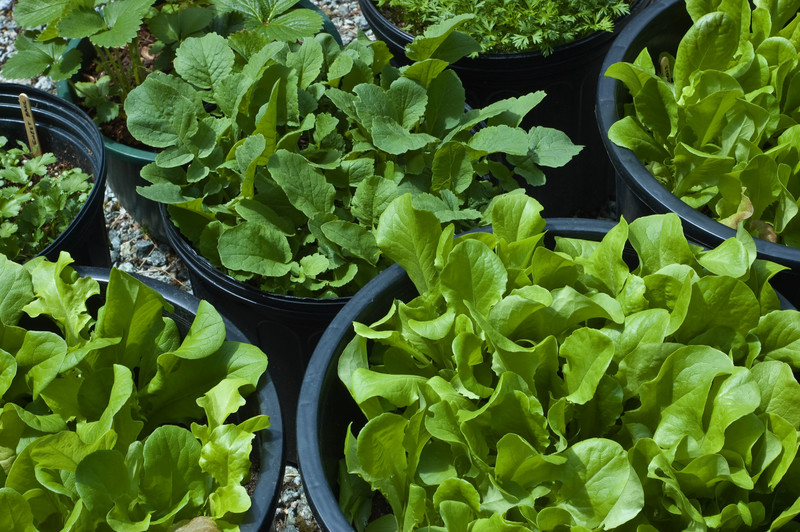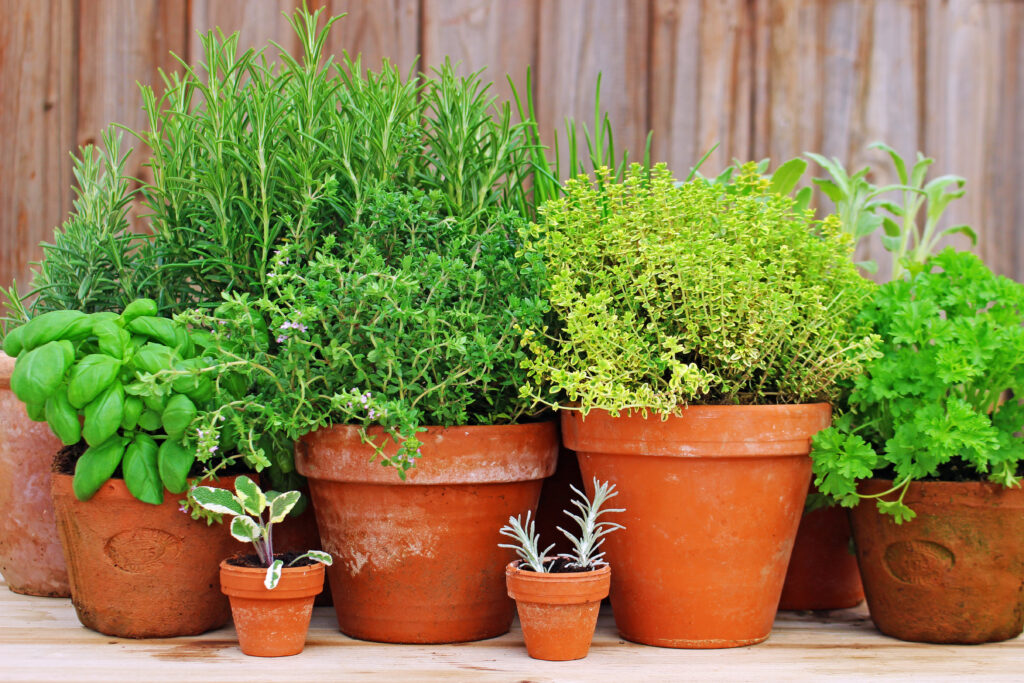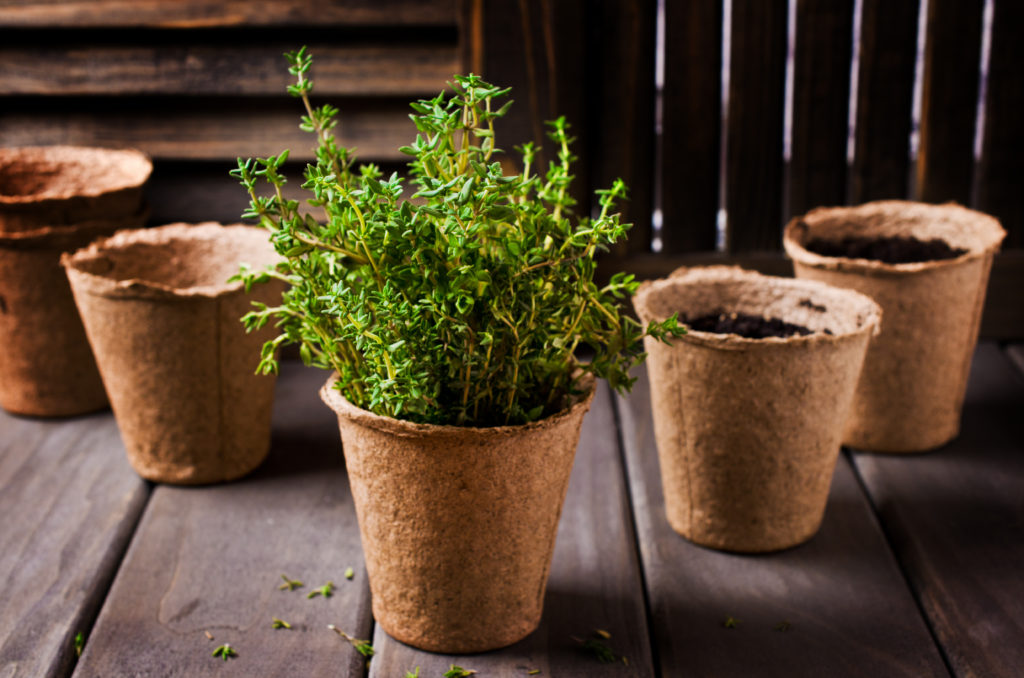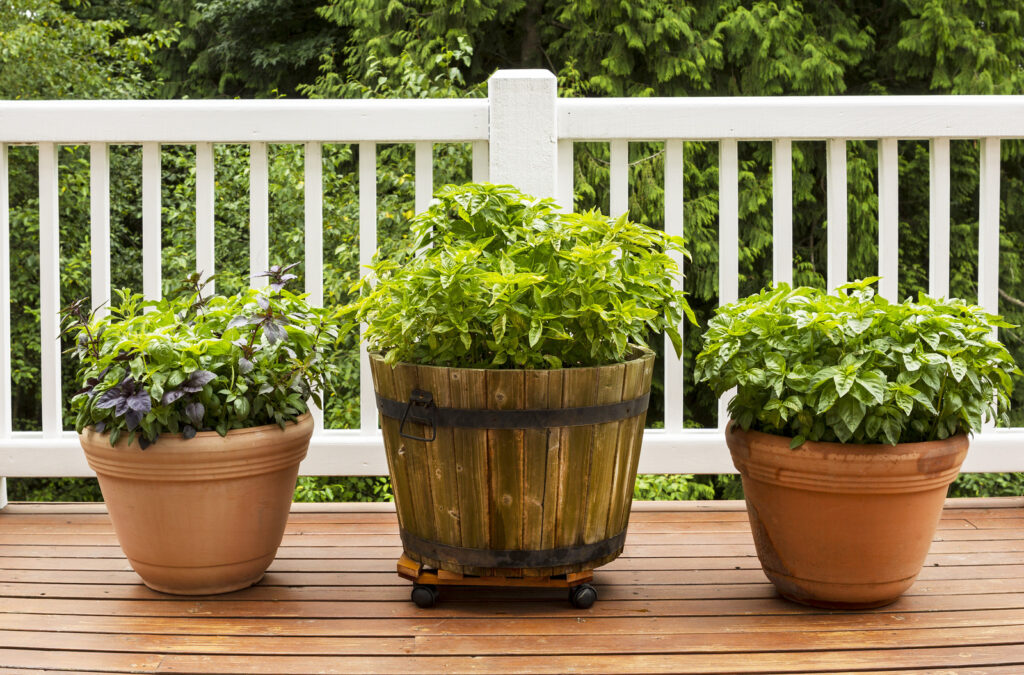Pots and containers for growing vegetables and herbs on patios, balconies, and rooftops must be large enough for the crop to mature. A container must hold the soil and moisture that deliver nutrients to growing plants allowing them to leaf, flower, and fruit. The pot must be large enough to accommodate the plant’s roots. And a pot should be large enough that the height and weight of the above-ground growth of the plant do not tip the container.
Some plants are small enough that you can grow more than one plant in a container; other plants grow so large that you would not want to grow more than a single plant in a container.

A soil depth of at least 8 inches/ 20 cm will hold sufficient soil, nutrients, and moisture to support a good yield from almost every vegetable and herb growing in a container. (Expect to water two or three times per week.) Smaller containers holding less soil may require more frequent watering and fertilizing.
Containers for Growing Plants at Amazon;
- Poly-resin 20-inch Grow Pot
- Self-Watering Planter for Herbs and Vegetables
- Galvanized Raised Bed 3x2x8ft
- Corten Steel Rectangular Planter

Suggested pot sizes for vegetable crops
The pot sizes listed here are for standard clay or black plastic nursery pots.)
- Asian Leaves—Mustard and Mizuna: Grow in at least 8-inch (20 cm) pots.
- Arugula: Grow in at least 8-inch (20 cm) pots. A good choice for growing in window boxes.
- Asparagus: Grow two plants in a 2-gallon (7.5L) container; grow up to five plants in a 10-gallon (38L) container.
- Beans: Allow at least 8 to 12 inches (20-30 cm) of soil depth for all beans. Plant bush beans at least 9 inches (23 cm) apart and pole beans 4 inches (10 cm) apart. Grow two plants in a 10-gallon (38L) container.
- Beets: Grow seven plants in a 2- or 3-gallon (7.5-11L) container and up to two dozen in a 10-gallon (38L) container; thin plant to 2-inches (5 cm) apart.
- Bok Choy: Grow one plant in an 8-inch (20 cm) pot.
- Broccoli: Grow one plant per 5- to 10-gallon (19-38L) container Start with young plants.
- Brussels sprouts: Grow one plant per 3-gallon (11-L) container; two in a 5-gallon or 10-gallon (19-38L) container. Start from seedlings.
- Cabbage: Grow one large head in a 2-gallon (7.5L) container; plant two per 3- to 5-gallon (11-19L) container then thin out weakest in a few weeks; grow three plants in a 10-gallon (38L) container.
- Carrots: Grow varieties that mature at 2-4 inches (5-10 cm) in 1- to 2-gallon containers (4-7.5L); varieties that mature 5-6 inches (13-15 cm) long use 5-gallon (19L) containers; varieties that mature 7-12 inches (18-30 cm) long use 10-gallon (38L) containers. Keep thinning until 2 inches (5 cm) apart. If the root tip touches the bottom of the pot, the carrot will not develop to maturity.
- Cauliflower: Grow one plant in a 3- to 5-gallon (11-19L) container; grow three in a 10-gallon (38L) container.
- Celery: Grow one plant in a 2-gallon (7.5L) bucket; grow five plants in a 10-gallon (38L) bucket.
- Chard: Grow one plant in a 2-gallon (7.5L) container; grow five plants in a 10-gallon (38L) container.
- Chicory: Grow three plants in an 18-inch (45 cm) pot.
- Chives: Start seed in a 3-inch (7.5 cm) pot; pot up the plant to an 8-inch (20 cm) pot.
- Collards: Grow two plants in a 2-gallon (7.5L) container and four in a 5-gallon (19L) container.
- Corn: Grow corn in containers with a soil depth of 8 inches (20 cm) or more. Grow three standard-size plants in a 15-gallon (57L) and six in a 30-gallon (114L) container. Six bantam types can be grown in a 15-gallon (57L) container. Space plants 4 inches (10cm) apart.
- Cucumbers: One compact type in a 5-gallon (19L) container and two to three standard variety plants in a 7- to 10-gallon (26-38L) container.
- Eggplant: Grow one plant per 5-gallon (19L) container. Grow two or three plants in a 10-gallon container.
See Garden Products Recommended by Harvest to Table
- Endive: Grow plants in an 18-inch (45 cm) container; thin plants to 8 inches (20 cm) apart.
- Garlic: Plant cloves 3 inches apart in a 5-gallon (19L) container.
- Horseradish: Grow one plant in a 5-gallon (19L) container or larger—this is a deep-rooted plant.
- Jicama: Grow one plant in a 3- to 5-gallon (11-19L) container.
- Kale: Grow one plant in a 1-gallon (4L) container; grow two plants in a 5-gallon (19L) container. In larger containers, thin plants to 16 inches (41 cm) apart.
- Kohlrabi: Grow one plant in an 8-inch (20 cm) pot.
- Leeks: Grow 18 plants in a 5-gallon (19L) container; 24 plants in a 10-gallon (38L) container. It’s best to grow leeks in a container at least 14 inches (35 cm) deep.
- Lettuce: Grow head lettuce in containers large enough to thin plants to 10 inches (25 cm) apart; grow crisp head, romaine, and butterhead lettuce in a container large enough to thin to 10 inches (25 cm) apart.

- Mustard Greens: Grow in at least 8-inch (20 cm) pots; thin plants to 4 inches (10 cm) apart.
- Melons: Grow one plant in a 5-gallon (19L) container or larger and two in a 10- to 15-gallon (38-57L) container.
- Okra: Grow one plant in a 10-gallon (38L) container or larger.
- Onions: Grow bulbing onions in a 24-inch (60 cm); don’t crowd your sets or seeds. The container should be at least 10 inches (24 cm) deep. Green onions can be grown in a shallower container.
- Orach: Grow one plant in a 12-inch (30 cm) pot.
- Peas, including Snow peas and Sugar snaps: Grow bush and climbing types in a 10-gallon (38L) container, a window, or planter box; space plants 2 inches (5 cm) apart. Put a construction wire trellis in place for them to grow up.
- Peppers: Grow one large bell pepper in a 3-gallon (11L) container or larger. Smaller chili plants will grow in less space. Space plants 12 inches (30 cm) apart.
- Potatoes: Grow potatoes in a container at least 12 inches (30 cm) wide and 12 inches (30 cm) deep. Plant four or five seed pieces in a 5-gallon (19L) container; plant 10 seed potatoes in a 15- to 20-gallon (57-76L) container or half whisky barrel.
- Pumpkins: Grow one vine in a 5-gallon (19L) or larger container.
- Radishes: Grow plants in soil 8-inch (20 cm) deep pot; thin plants from 1- to 2-inches (2.5-5 cm) apart.
- Rhubarb: Grow one plant in a 10-gallon (38L) container or larger.
- Rutabaga: Grow 15 or 16 plants in a 15- or 20-gallon (57-74L) container.
- Scallions: Grow plants in an 18-inch (45 cm) pot; thin plants to 2 inches (5 cm) apart.
- Sorrel: Grow in a 12-inch (30 cm) pot.
See 10-gallon nursery pots here. And 10-gallon grow bags here.
See 15-gallon nursery pots here. And 15-gallon grow bags here.
See Garden Products Recommended by Harvest to Table
- Spinach: Grow three plants in a 2-gallon (7.5L) container; grow ten plants in a 10-gallon (38L) container; thin plants to about 5 inches (13 cm) apart.
- Squash: Grow one plant in a 5-gallon (19L) container, larger is better. Plant two vining plants in a 10-gallon (38L) container.
- Sweet Potatoes: Use a 20-gallon (76L) container or half whiskey barrel.
- Swiss Chard: Grow plants in 12-inch (30 cm) or larger pots; thin plants to 8 inches apart.
- Tomatoes: Grow one large variety in a 10-gallon (38L) container–a 15- to 20-gallon (57-76L) container is better. Miniature tomatoes can be grown in a 5-gallon (19L) container. Start tomato seed in a 3-inch (7.5 cm) pot then pot up to a 5-inch (12.5 cm) pot, and continue potting up until you set the plant outside
- Turnips: Grow 15 or 16 plants in a 15- or 20-gallon (57-76L) container.
- Zucchini: Grow one plant in a 12- to 18-inch (30-45 cm) pot.

Containers must be well drained
Good drainage is essential when growing plants in containers. Containers less than 10 inches/25 cm in diameter should have a hole ½ inch/ 1.2 cm in diameter to provide good drainage. Containers greater than 10 inches in diameter need two to four holes.
Also of interest:
See Garden Products Recommended by Harvest to Table
Garden Planning Books at Amazon:
- Vegetable Garden Grower’s Guide
- Tomato Grower’s Answer Book
- Vegetable Garden Almanac & Planner
- Kitchen Garden Grower’s Guide Vegetable Encyclopedia















